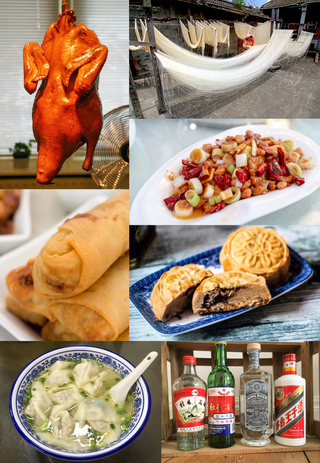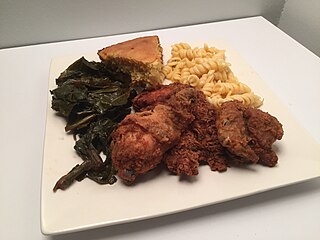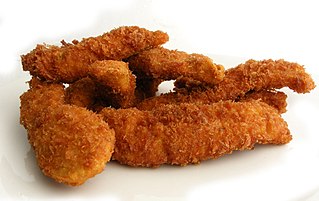Related Research Articles

American Chinese cuisine is a cuisine derived from Chinese cuisine that was developed by Chinese Americans. The dishes served in many North American Chinese restaurants are adapted to American tastes and often differ significantly from those found in China.

Chinese cuisine comprises cuisines originating from China, as well as from Chinese people from other parts of the world. Because of the Chinese diaspora and historical power of the country, Chinese cuisine has profoundly influenced many other cuisines in Asia and beyond, with modifications made to cater to local palates. Chinese food staples such as rice, soy sauce, noodles, tea, chili oil, and tofu, and utensils such as chopsticks and the wok, can now be found worldwide.

Soul food is the ethnic cuisine of African Americans. It originated in the American South from the cuisines of enslaved Africans trafficked to the North American colonies through the Atlantic slave trade during the Antebellum period and is closely associated the cuisine of the American South. The expression "soul food" originated in the mid-1960s when "soul" was a common word used to describe African-American culture. Soul food uses cooking techniques and ingredients from West African, Central African, Western European, and Indigenous cuisine of the Americas.

The cuisine of the Southern United States encompasses diverse food traditions of several subregions, including cuisine of Southeastern Native American tribes, Tidewater, Appalachian, Ozarks, Lowcountry, Cajun, Creole, African American cuisine and Floribbean cuisine. In recent history, elements of Southern cuisine have spread to other parts of the United States, influencing other types of American cuisine.

Taiwanese cuisine is a popular style of food with several variations, including Chinese and that of Taiwanese indigenous peoples, with the earliest cuisines known of being the indigenous ones. With over a hundred years of historical development, mainstream Taiwanese cuisine has been influenced by Hakka cuisine, the cuisines of the waishengren, Japanese cuisine, and American cuisine, with southern Fujian cuisine having had the most profound impact.

Cannoli is a Sicilian pastry consisting of a tube-shaped shell of fried pastry dough, filled with a sweet, creamy filling containing ricotta cheese. Its size ranges from 9 to 20 centimetres. In mainland Italy, it is commonly known as cannolo siciliano.

Stir frying is a cooking technique in which ingredients are fried in a small amount of very hot oil while being stirred or tossed in a wok. The technique originated in China and in recent centuries has spread into other parts of Asia and the West. It is similar to sautéing in Western cooking technique.

Chop suey is a dish from American Chinese cuisine and other forms of overseas Chinese cuisine, generally consisting of meat and eggs, cooked quickly with vegetables such as bean sprouts, cabbage, and celery, and bound in a starch-thickened sauce. It is typically served with rice, but can become the Chinese-American form of chow mein with the substitution of stir-fried noodles for rice.

Chow mein is a dish of Chinese stir-fried noodles with vegetables and sometimes meat or tofu. Over the centuries, variations of chǎomiàn were developed in many regions of China; there are several methods of frying the noodles and a range of toppings can be used. It was introduced in other countries by Chinese immigrants. The dish is popular throughout the Chinese diaspora and appears on the menus of most Chinese restaurants abroad. It is particularly popular in India, Nepal, the UK, and the US.

Delia Ann Smith is an English cook and television presenter, known for teaching basic cookery skills in a direct style. One of the best known celebrity chefs in British popular culture, Smith has influenced viewers to become more culinarily adventurous. She is also notable for her role as joint majority shareholder at Norwich City F.C.

Scallions are edible vegetables of various species in the genus Allium. Scallions generally have a milder taste than most onions. Their close relatives include garlic, shallots, leeks, chives, and Chinese onions.

Chicken fingers are chicken meat prepared from the pectoralis minor muscles of the animal. These strips of white meat are located on either side of the breastbone, under the breast meat. They may also be made with similarly shaped pieces cut from chicken meat, usually the breast, or sometimes just pulverized chicken flesh.

Canadian Chinese cuisine is a cuisine derived from Chinese cuisine that was developed by Chinese Canadians. It was the first form of commercially available Chinese food in Canada. This cooking style was invented by early Cantonese immigrants who adapted traditional Chinese recipes to Western tastes and the available ingredients, and developed in a similar process to American Chinese cuisine.

Chinese cooking techniques are a set of methods and techniques traditionally used in Chinese cuisine. The cooking techniques can either be grouped into ones that use a single cooking method or a combination of wet and dry cooking methods.

Cap cai, sometimes spelled cap cay, is the Hokkien-derived term for a popular Chinese Indonesian and Peranakan stir fried vegetable dish that originates from Fujian cuisine.

Yuxiang is a seasoning mixture in Chinese cuisine, and also refers to the resulting sauce in which meat or vegetables are cooked. It is said to have originated in Sichuan cuisine, and has since spread to other regional Chinese cuisines.
Fu Pei-mei was a Taiwanese waishengren chef. She wrote over 30 cookbooks on Chinese cuisine, and produced and hosted cooking programs on Taiwan Television and Japan's NHK. In 2012, she was posthumously awarded the special award at the 47th Golden Bell Awards ceremony.
Pei Mei's Chinese Cook Book is a cookbook series by Fu Pei-mei, written in both Chinese and English. There were three volumes, the first published in 1969 and the last published in 1979.
References
- ↑ Davis, Emily (September 16, 2020). "The joy of Chinese cooking". The University of North Carolina at Chapel Hill . Retrieved July 7, 2024.
- ↑ "Michelle King | Department of History". The University of North Carolina at Chapel Hill . Retrieved July 7, 2024.
- ↑ "Teaching Chinese Food History in a Pandemic Era". weai.columbia.ed. May 3, 2022.
- ↑ Force, Thessaly La (May 12, 2024). "She Taught Generations How to Wield a Wok and a Cleaver". The New York Times . ISSN 0362-4331 . Retrieved July 7, 2024.
- ↑ Julian, Sheryl (May 16, 2024). "Michelle T. King's 'Chop Fry Watch Learn' remembers Fu Pei-mei, the woman who brought Chinese food to TV — and the world - The Boston Globe". Boston Globe . Retrieved July 7, 2024.
- ↑ "Meet Fu Pei-mei, Taiwan's first TV cooking star | Good Food". KCRW. June 21, 2024. Retrieved July 7, 2024.
- ↑ "Two books trace the social and historical impacts of food". NPR . May 31, 2024. Retrieved July 7, 2024.
- ↑ Scholliers, Peter (March 14, 2020). "Culinary nationalism in Asia: edited by Michelle T. King, London, Bloomsbury Academic, 2019, 282 pp., ISBN 978-1-3500-7867-3". Food, Culture & Society. 23 (2): 267–268. doi:10.1080/15528014.2020.1713035. ISSN 1552-8014.